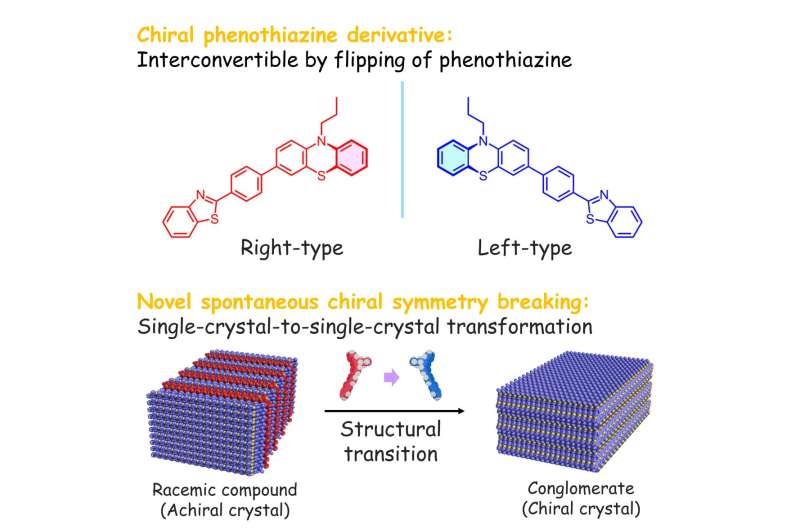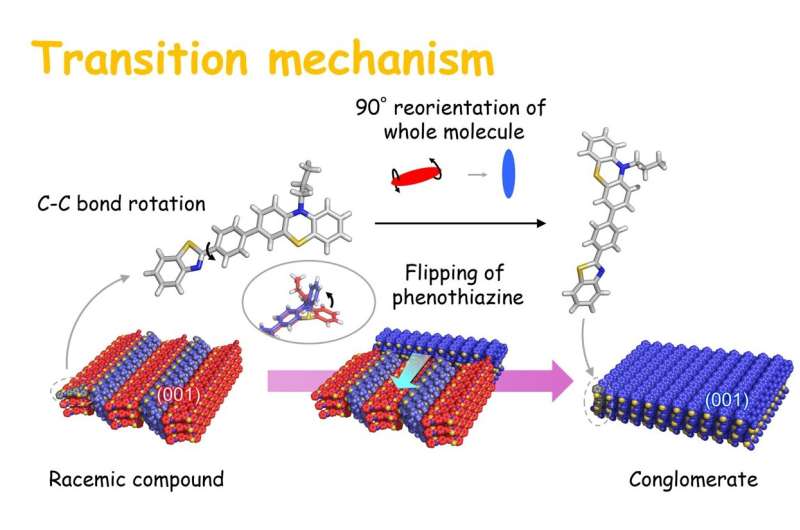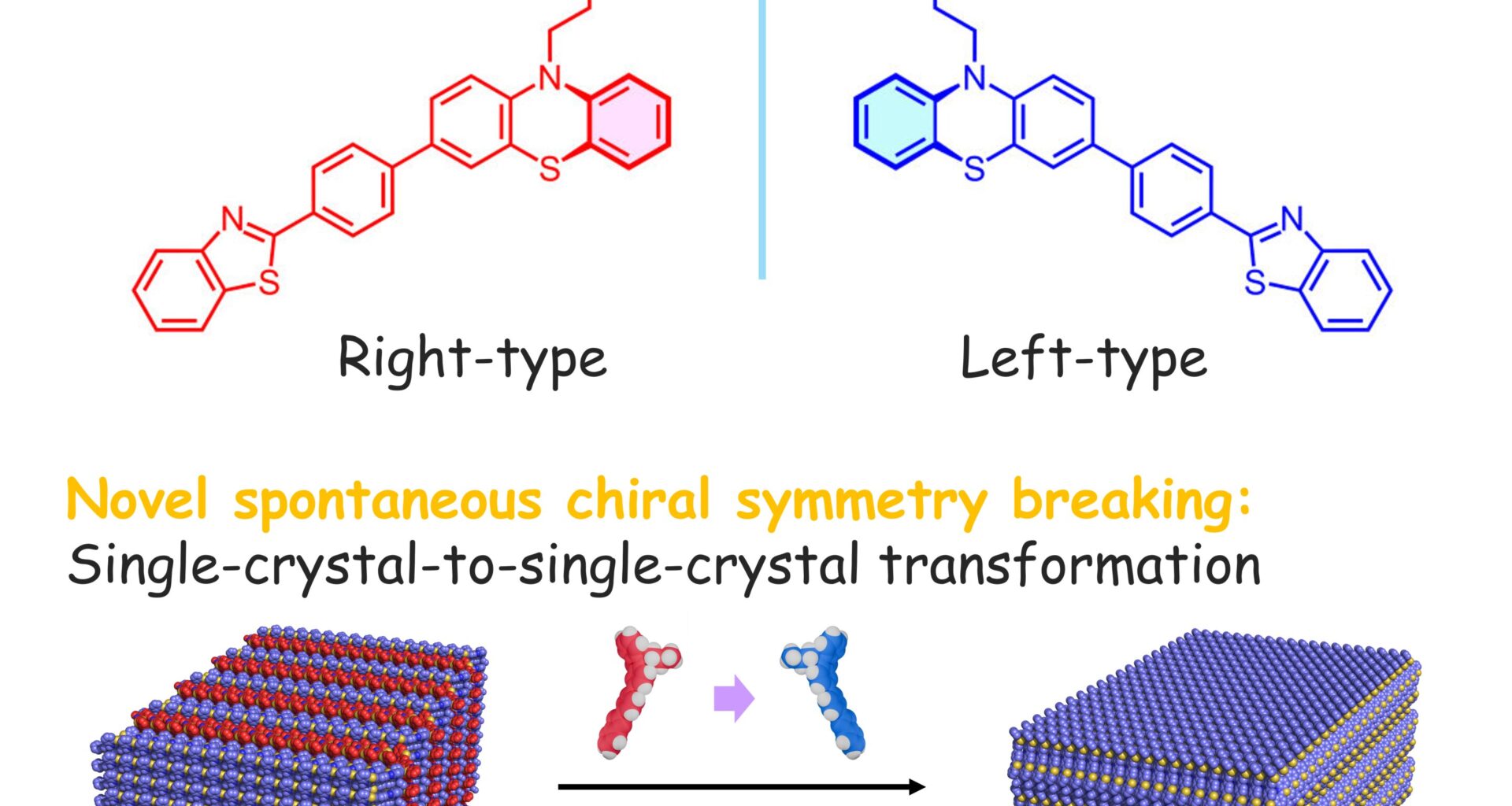
Novel spontaneous chiral symmetry breaking with in a single crystal. Credit: Spontaneous chiral symmetry breaking in a single crystal, Chemical Science 2025, Ryusei Oketani et al.,
Researchers at The University of Osaka have discovered a new type of chiral symmetry breaking (CSB) in an organic crystalline compound.
This phenomenon, involving a solid-state structural transition from an achiral to a chiral crystal, represents a significant advance in our understanding of chirality and offers a simplified model to study the origin of homochirality. This transformation also activates circularly polarized luminescence, enabling new optical materials with tunable light properties.
The work has been published in Chemical Science.
Chirality, or “handedness,” is a fundamental property of objects, from galaxies to molecules, and plays a crucial role in biological systems. However, chiral compounds in living organisms, such as sugars and amino acids, exist almost exclusively in a single form.
This phenomenon, known as “biological homochirality,” has long puzzled scientists, and its underlying mechanism remains elusive. Understanding how a preference for one chiral form over the other arises is crucial for comprehending the origin of life itself.
Microscopic movie of the chiral symmetry breaking through the transition. Credit: 2025, Ryusei Oketani et al., Spontaneous chiral symmetry breaking in a single crystal, Chemical Science
Previously, two types of CSB phenomena, preferential enrichment and Viedma ripening, have been observed in solutions. However, the complexity of these solution-based systems makes it challenging to pinpoint the precise mechanisms driving CSB.
The University of Osaka team’s discovery of a solid-state CSB provides a drastically simplified model for studying this phenomenon. They found that a chiral phenothiazine derivative can transition from an achiral crystalline form to a chiral one while maintaining single crystallinity. This transition involves the inversion of molecular chirality within the crystal lattice without any external influence such as solvents or impurities.
This unique solid-state CSB offers significant advantages for studying the fundamental principles governing chiral selection. The simplicity of the system allows for detailed structural analysis using techniques like X-ray diffraction, enabling researchers to visualize the molecular movements during the transition.

Structural transition under polarized microscope and plausible transition mechanism. Credit: 2025, Ryusei Oketani et al., Spontaneous chiral symmetry breaking in a single crystal, Chemical Science
This provides valuable insights into the dynamics of CSB, potentially revealing the underlying mechanisms responsible for homochirality in biological systems. Furthermore, the transition triggers a “turn-on” of circularly polarized luminescence (CPL), opening up possibilities for developing novel optical materials with switchable CPL properties.
This discovery has profound implications for understanding the origin of homochirality and its role in the development of life. Furthermore, this research could pave the way for the development of advanced materials with tailored chiral properties for applications in pharmaceuticals, electronics, and other fields.
“It’s fascinating how life is composed of only one enantiomer of amino acids, and how this chirality manifests in our bodies,” stated Dr. Ryusei Oketani at the University of Osaka, who led the research.
“This study represents a major step toward understanding how chiral molecules become biased toward one form and how their assembled structures develop. While this seems like fundamental research, chiral molecules are key components of pharmaceuticals and next-generation materials. This work provides a foundation for efficiently producing these essential substances.”
More information:
Ryusei Oketani et al, Spontaneous chiral symmetry breaking in a single crystal, Chemical Science (2025). DOI: 10.1039/D5SC02623G
Provided by
University of Osaka
Citation:
Scientists discover new phenomenon in chiral symmetry breaking (2025, August 19)
retrieved 19 August 2025
from https://phys.org/news/2025-08-scientists-phenomenon-chiral-symmetry.html
This document is subject to copyright. Apart from any fair dealing for the purpose of private study or research, no
part may be reproduced without the written permission. The content is provided for information purposes only.
